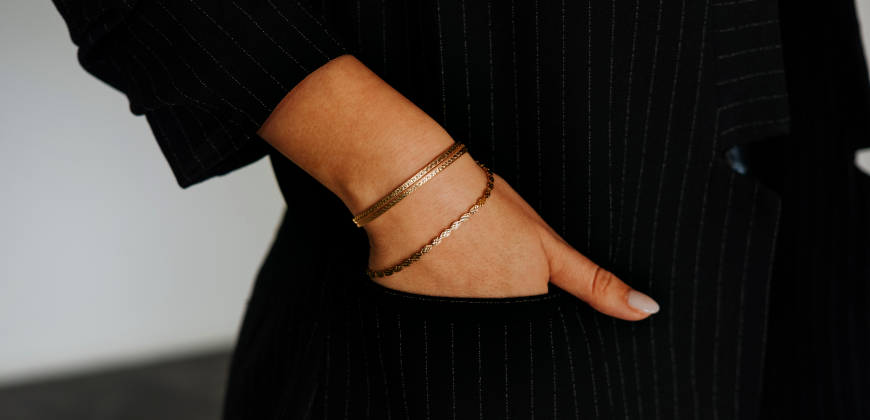
From dainty, sparkly tennis bracelets to chunky gold or silver cuff bracelets, wrist “candy” needs to be sized perfectly for you to wear without losing them or cutting off your circulation. But some bracelets are meant to be worn more tightly, while others can have a little room to move up and down your wrist— especially if they are bangles which are designed to be worn together and make a little noise!
Determine your Wrist Size First
The best place to start is knowing exactly what your wrist size is for starters. To measure, use a flexible measuring tape like the ones used for sewing and measuring material. But if you don’t have that available, you can also use other things you can wrap around your wrist and measure on a standard ruler afterward, like rope, twine, dental floss or even a strip of paper. No matter what you use, don’t wrap it tightly for this measurement. Just wrap it snugly so there’s very little space between your wrist and the measuring device. Where the ends meet, then, is the total circumference of your wrist. Generally, the average length for a women’s bracelet is somewhere between six and eight inches, but the size you order a bracelet in depends on the type of bracelet you are getting and how it should fit on your wrist. Let’s take a look at different types of bracelets.
Cuff Bracelets
While today’s cuff bracelets range in size from petite to extra-large, they originally appeared on women’s arms in ancient civilization in bold metal forms and extra-large sizes. Think of Cleopatra, and in later years, Wonder Woman, and one of the first things you will envision is a wide cuff on each of their wrists. And while these early versions typically represented power, the more petite versions of cuff bracelets today add more elegance than power to your apparel.
So how do you want a cuff bracelet to fit? Since it generally doesn’t have any clasp to hold it onto your wrist, a cuff bracelet needs to fit more closely to your wrist than other styles, so it doesn’t fall off. If you measured your wrist and found it to be seven inches, you would want a cuff bracelet that is exactly that. Remember that a cuff bracelet by definition has a slit or opening through which to wiggle your wrist through to put it on, and that opening is part of the entire circumference of the bracelet. A cuff bracelet should be worn above your wrist bone, so be sure to measure the part of your wrist that sits above that so it doesn’t slip down toward your hand.
Tennis Bracelets
Opposite the cuff bracelet for fit, diamond tennis bracelets need to have a little breathing room on your wrist. Featuring a single row of identical diamonds, the tennis bracelet is an elegant addition to your “little black dress” nights or formal wear evenings for sure, but are made to be so comfortable that you can wear them every day, too. But you want a little movement in the bracelet so those diamonds can catch the light as it moves gracefully on your wrist. A general rule of thumb is that you should be able to slide one finger between the bracelet and your wrist for the perfect fit. Wear it alone to draw attention to its exquisite design or use it to accent other bracelets or even your watch.
Bangles
The loosest fitting of all bracelets are bangles. Bangles are designed to be worn in pairs or more, creating an attractive look—and sound—on your wrist. Bangles should fit at least two fingers in between your wrist and finger for the perfect fit. But remember that bangles do not have a clasp or closure of any kind, nor do they have an opening. So, in order to measure for the perfect fit, you actually need to measure the distance between your knuckle and edge of your hand when you bring all your fingers together as if you are sliding on a bangle. Measure from the outside knuckle of your thumb to the outside of your hand using a flat ruler. Generally, this number will be somewhere between 2- and 4-inches wide, which tells you the diameter of the bangle. Alternatively, you can use a flexible measuring tape to measure all the way around your hand and this will be the circumference of the bangle you need. This also explains why bangles are generally larger than other bracelets as they have to fit over your bunched-up hand to get them on.
Chains
A chain bracelet is one that is made of links that are connected with one another all the way around the bracelet and closed with a clasp. Some are lightweight and dainty, while others are heavy and bold. Regardless of size or weight, the fit for a chain bracelet remains the same as that of a tennis bracelet. It should not fit too tightly that you can’t fit one finger inside the bracelet when you’re wearing it as it needs a little room to move up and down your wrist.
Buying a new bracelet can be exciting, but to really get the best fit, you need to do a little work first in measuring your wrist for the perfect fit depending on the style of bracelet you are looking to buy. But once you do your homework, when you find that perfect bracelet, it’s sure to fit like a glove! Be sure to secure insurance for your favorite bracelet. We provide all types of jewelry insurance, protecting your bracelet from loss, theft, damage and disappearance! While many pieces of jewelry are insured using a homeowners policy, insuring your jewelry with a standalone policy protects your home insurance from the effects of a claim and you can choose a $0 deductible option as well. Get a quote online today and see how affordable it can be.
